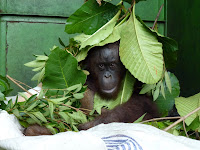By volunteer Laurence from Hong Kong
25 September 2012 was a memorable day for me as a
volunteer for IAR in Bogor, Indonesia. I was glad to be in the team for the
rescue of a Javanese slow loris, Laura. I was really lucky to have an
opportunity like this, particularly as I’m not able to stay here all that long!
In the morning of that day, I was told that there would
be a rescue of a slow loris from a village near the primate rehabilitation
centre here. It had been reported to IAR that someone in the village had a slow
loris at their home and they would like to hand it over. We set off in the
afternoon with a veterinarian, Dr Anne Dawydowa, and two IAR staff. All of us
were excited to see the slow loris but, at the same time, also worried about
the condition it would be in.
The location was just a small village. We wondered how they
could have bought a slow loris from an animal market. Or even worse, had they
captured it from the wild? I was curious to know where they had got this animal...
When we arrived, someone from the house took us to the
slow loris. She had been put in a pet cage with a flattened cardboard box and
some mango as food inside. She seemed scared to be exposed and was huddling in
the corner. However, she still looked bright and not as bad as we had imagined.
We had prepared a transport box with shade for the slow loris, so our vet tried
to get Laura out of the pet cage and into our box as quickly as possible in
order to reduce her stress. Slow lorises are nocturnal animals and they have a
shy nature. Being exposed to sunlight and surrounded by people can be very
stressful for them.

Unfortunately, some bloody stains were found on the cardboard
box while our vet was handling the slow loris. We discovered that she was
bleeding slightly from two wounds. One was between her index finger and thumb
and another one was on her wrist. It was also noticed that some of her teeth
were missing. This is very common among the slow lorises sold in the animal
market and is done to prevent them biting the traders. Our vet put her quickly
and carefully into our box, and some foliage as well, so that she would be more
comfortable in a familiar environment. We covered the box well and then asked
the owner some questions about Laura.
According to the owner, he had found the slow loris two
weeks previously in a swimming pool and had brought it back home. It seemed he
didn't even know what kind of animal it was as he looked surprised when he was
told that it was a 'kukang' (slow loris in Indonesian.)
It was possible that he didn't intend to keep it as pet,
but found he didn't know much about handling this 'kukang' after having taken
it back home and so contacted IAR for help.
Our action was not only taking Laura but, more importantly,
also educating the local people that wild animals should not be kept as pets.
Their understanding could prevent similar stories happening again. So this was
a real 'rescue operation’ for all slow lorises in Indonesia, not just Laura.
Laura is now in the care of our veterinary team and her
wounds seem much better. We will keep on observing both her physical and
behavioural status. Hopefully one day
she can be released back to where she belongs.





.JPG)











































